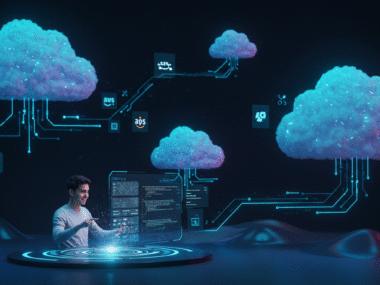In a world drowning in data, one profession stands tall as the ultimate treasure hunter, turning raw numbers into gold mines of insight. That’s the magic of being a data scientist, and in 2025, it’s not just a job—it’s a launchpad to a life of innovation, fat paychecks, and real-world superpowers. If you’ve ever wondered why data science jobs are exploding right now, or if a data scientist salary could change your financial game, stick around. We’re diving deep into why this career tops the charts for anyone smart enough to grab it.
Data science isn’t some fleeting tech fad; it’s the backbone of everything from your Netflix binge to life-saving medical breakthroughs. As we hit 2025, businesses, governments, and even startups are scrambling for pros who can wrangle massive datasets and spit out predictions that drive decisions. Think about it: every click you make online, every purchase you scan, generates data that needs decoding. And who gets to play detective? Data scientists. With job growth projected at a whopping 34 percent through 2034, way ahead of the pack, it’s clear this field’s got legs. But let’s break it down—why exactly does it feel like the best gig going?
The Insane Demand Driving Data Science Jobs in 2025
Let’s start with the elephant in the room: demand. In 2025, data science jobs aren’t just available; they’re everywhere, and they’re begging to be filled. The U.S. Bureau of Labor Statistics forecasts about 23,400 openings each year for data scientists, fueled by a surge in big data analytics across industries. That’s not hype—it’s reality. Companies that ignored data a decade ago are now betting their futures on it. Why? Because in an era of AI boom and economic uncertainty, the ones who master data win big.
Take healthcare, for starters. Post-pandemic, hospitals are using data to predict outbreaks, personalize treatments, and cut costs. A data scientist here might build models that spot early signs of diseases, saving lives and millions. Or flip to finance: banks rely on fraud detection algorithms to thwart hackers in real-time. One wrong move, and it’s billions down the drain. Data pros are the guardians.
But it’s not all corporate giants. Small businesses are jumping in too. E-commerce shops use customer data to tweak recommendations, boosting sales by 20-30 percent overnight. Even nonprofits crunch numbers to optimize aid distribution in disaster zones. The point? No matter your passion—tech, environment, entertainment—data science slots right in.
Now, here’s the kicker: the market’s evolved. Entry-level spots are tougher due to bootcamp grads flooding in, but mid-to-senior roles? They’re gold. Postings demanding generative AI skills skyrocketed to nearly 10,000 by mid-2025, showing how the field’s shifting toward cutting-edge tools. If you’re skilled, you’re not job hunting—you’re being hunted. Networking on LinkedIn or X (formerly Twitter) can land interviews faster than you can say “Python script.”
And globally? It’s even hotter. Emerging markets in Asia and Africa are data-starved, creating remote opportunities for U.S.-based talent. Freelance platforms like Upwork see data gigs paying premium rates, often $100+ per hour. In short, if stability’s your jam, data science delivers. No more layoff fears like in volatile sectors; this one’s recession-proof.
Lucrative Paychecks: Unpacking the Data Scientist Salary in 2025
Ah, money talks, and in data science, it shouts. Let’s get real about the data scientist salary in 2025—it’s the kind of figure that makes accountants jealous. On average, you’re looking at $126,000 base pay, plus bonuses pushing total comp to $144,000. That’s median, folks. Entry-level? Around $100,000 if you’ve got the chops. Seasoned pros? Easily $200,000+, especially in tech hubs like San Francisco or New York.
Why so juicy? Scarcity meets value. Companies shell out because one good hire can ROI in months—think optimizing ad spends to save millions or forecasting inventory to slash waste. Remote work sweetens it too: fully virtual data scientists average $122,738, with less commute hassle.
Break it down by experience:
- Junior (0-2 years): $95,000-$110,000. Fresh grads with a bootcamp cert can hit this quick.
- Mid-level (3-5 years): $120,000-$150,000. Here, ML expertise kicks in bonuses.
- Senior (6+ years): $160,000-$215,000. Leadership roles add equity, perks like stock options.
Location matters, but less now. Austin or remote spots match coastal pay without the rent gouge. Women and underrepresented groups? The gap’s narrowing, with initiatives pushing equity—salaries up 5-7 percent in diverse hires.
Benefits? Oh yeah. Unlimited PTO, home office stipends, learning budgets for conferences like NeurIPS. It’s not just pay; it’s a lifestyle upgrade. Compare to teaching ($60k average) or marketing ($80k)—data science laps them.
Industries Leading the Charge: Where Data Scientists Shine Brightest
Diversity in opportunities keeps data science fresh. In 2025, top industries hiring data scientists read like a who’s who of innovation: healthcare, finance, retail, tech, and e-commerce top the list. Each brings unique flavors, so pick your poison.
Healthcare and Pharma: This sector’s a beast, with data pros predicting patient flows or drug efficacy. Salaries skew high—$140k average—thanks to regulatory demands. Imagine modeling genomic data to tailor cancer treatments; it’s heroic stuff.
Finance and Banking: Risk assessment, algorithmic trading, personalized banking apps. Fintech startups like Chime hire aggressively, offering equity that could moonshot your wealth. Expect $150k+ in NYC.
Retail and E-Commerce: Amazon, Walmart—they live by data. Optimize supply chains, personalize carts, fight returns. It’s fast-paced, with A/B testing galore. Pay: $130k, plus performance bonuses.
Tech and Entertainment: Google, Netflix—data drives your feed. Build recommendation engines or analyze viewer trends. Silicon Valley perks? Free meals, gyms, and that elusive work-life blend.
Emerging Players: Manufacturing uses IoT data for predictive maintenance; energy firms model renewables. Even government gigs, like census analytics, offer stability.
The beauty? Crossovers. Start in retail, pivot to healthcare. Versatility means job security. And with 35 percent growth projected to 2032, these doors stay wide open.
Skills That Make You a Data Science Rockstar in 2025
Jumping into data science? It’s accessible but demands hustle. Core skills haven’t changed much, but 2025 amps up AI twists. Start with programming: Python’s king, R for stats-heavy work, SQL for queries. No PhD needed—a bachelor’s in math, CS, or stats opens doors, but bootcamps bridge gaps fast.
Must-Haves:
- Statistics and Probability: The heart of it. Understand distributions, hypothesis testing to avoid garbage-in-garbage-out models.
- Machine Learning: From regression to neural nets. Tools like TensorFlow or Scikit-learn are table stakes. GenAI integration? Learn prompt engineering for tools like ChatGPT in analysis.
- Data Wrangling: Clean messy data with Pandas. Real-world sets are 80 percent chaos—master this, and you’re golden.
- Communication: Tech speak’s useless without stories. Visualize with Tableau, explain to execs sans jargon. This skill lands promotions.
- Domain Knowledge: Tailor to industry. Healthcare? Brush up on HIPAA. Finance? Risk metrics.
Soft skills? Curiosity, ethics—bias in models can tank trust. Upskill via free resources: Kaggle datasets, Coursera specials. In 2025, edge skills like AutoML or edge computing set you apart. Dedicate 5-10 hours weekly; in six months, you’re interview-ready.
Pro tip: Build a portfolio. GitHub repos of projects—like sentiment analysis on tweets—scream “hire me” louder than resumes.
The Future Beckons: AI Fusion and Trends Shaping Data Science
Fast-forward to 2025: data science isn’t solo anymore; it’s tangled with AI like peanut butter and jelly. Agentic AI—systems that act autonomously—is the buzz, letting data pros offload grunt work for high-level strategy. Imagine AI handling data prep while you dream up quantum-safe models.
Trends to watch:
- Unstructured Data Domination: 80 percent of data’s text, images, video. NLP and computer vision tools explode, powering chatbots or self-driving cars.
- Ethical AI Push: Regulations like EU AI Act demand fair models. Data scientists as “ethics officers”? It’s coming, adding purpose.
- AutoML and Democratization: No-code tools lower barriers, but experts thrive by customizing. Quantum computing? Early days, but it’ll crunch impossibles.
- Sustainability Angle: Green data science optimizes energy use in data centers, a hot niche.
By 2026, demand outstrips supply by 50 percent in the U.S. Stay agile—certifications in AWS ML or Google Data Analytics keep you ahead. The field’s not dying; it’s morphing into something epic.
Flexibility and Balance: Why Data Science Feels Like a Dream Job
Burnout’s real, but data science dodges it smartly. Remote work’s norm—70 percent of roles hybrid or fully virtual—meaning pajamas coding from Bali? Possible. Flexible hours suit night owls or parents; async teams mean no soul-crushing meetings.
Perks stack up: mental health days, gym memberships, even sabbaticals after five years. Tech firms lead, but banks catch up. Surveys show data pros report 20 percent higher satisfaction than average workers, thanks to autonomy. You own projects end-to-end, from hypothesis to dashboard.
Global nomadism? Time zones align for collabs with Europe or Asia teams. And downtime? Weekends free for hikes, not emails. It’s careers with soul—intellectually stimulating without the grind.
Making Waves: The Real-World Impact of Data Science Careers
Ever feel like your job’s a cog? Not here. Data scientists shape society. In climate fight, models predict floods, guiding evacuations. In education, adaptive learning platforms boost scores for underserved kids.
Social good aside, business wins: a retail chain’s churn model retains customers, adding revenue. Personally? That “aha” moment when your algo nails a forecast—pure adrenaline. It’s creative problem-solving meets hard science, leaving legacies.
Tackling Hurdles: Challenges in Data Science and How to Crush Them
No rose without thorns. 2025’s data scene has bumps: AI hype sparks “replacement” fears, but it’s evolution, not extinction—pros who wield AI thrive. Oversaturation hits juniors; counter with niches like bio-data.
Data quality? Garbage persists—invest in validation tools. Privacy laws fragment globally; stay compliant via courses. Scalability? Cloud platforms like Azure ease it.
Bias? Audit models rigorously. Solutions: mentorship networks, continuous learning. Challenges build resilience; overcome them, and you’re unbreakable.
Kickstarting Your Data Science Journey in 2025: Step-by-Step
Ready to dive? Step one: assess skills. Free audits on DataCamp. Two: learn basics—Python via Codecademy, three months tops. Three: projects. Analyze public data on UCI repo.
Four: network. Join Data Science Central, attend virtual meetups. Five: certify—Google’s free, or IBM’s advanced. Six: apply strategically—tailor resumes to ATS, highlight impact.
Timeline: six months to first gig if dedicated. Resources abound; no excuses.
Inspiring Tales: Data Scientists Who Made It Big
Meet Sarah, ex-teacher turned data whiz. Bootcamp in 2023, now at Mayo Clinic earning $140k, modeling pandemics. Or Raj, Indian immigrant freelancing ML for startups, hitting $180k remote.
These stories? Proof it’s doable. Grit plus smarts equals success.
Conclusion
So, why’s data science the best career in 2025? Skyrocketing demand, envy-worthy pay, endless impact—it’s a no-brainer. Whether chasing stability or adventure, it fits. Don’t wait; the data’s calling. Start today, and tomorrow, you’ll be the one others envy.
For more on job stats, check the U.S. Bureau of Labor Statistics Occupational Outlook. Ready to skill up? Explore courses at Coursera Data Science Guide.











